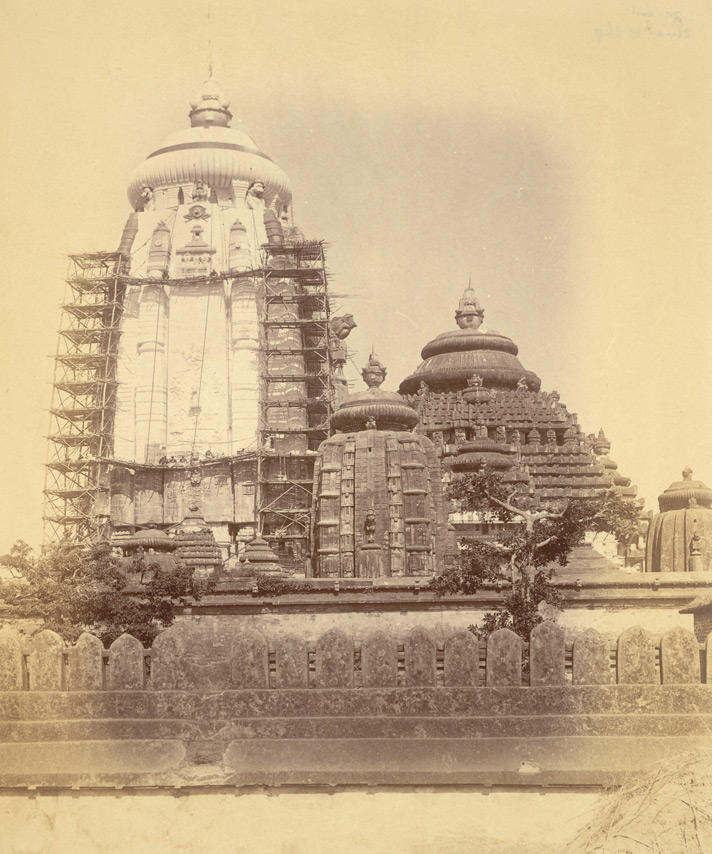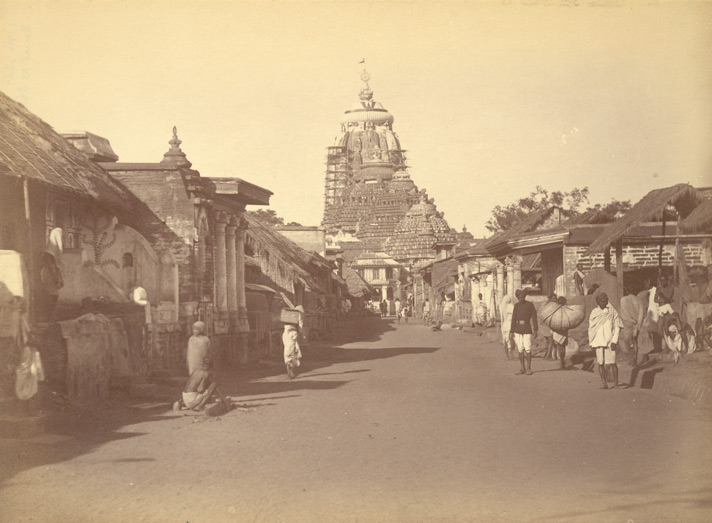In 1692 A.D. Aurangzeb the Moghul Emperor issued an order to destroy the temple of Lord Jagannath. At that time Divyasingha Deva was the king of Khurda. Ekram Khan was the Nawab of Orissa who waged this invasion on the temple with the help of his brother Mastram
Khan. The Nawab entered the temple and climbed to the - golden throne
of Jagannath. The treasure of the temple was looted. The King was unable
to face the invader hidden in an unknown place. Lord Jagannath was
hidden behind the‘Bimala Temple’ in the precinct of the Srimandir. The triad were shifted one after another to ‘Maa Bhagabati Temple’ at Gadakokal located at Brahmagiri block. As per records of the‘Madalapanji’ the Bije- pratima (Representatives of Lords) were transferred to Gadakokal. Then the deities were shifted to Bada Hantuada in Banpur across the Chilika Lake. The deities were returned to Puri in 1699 A.D. This was the sixteenth invasion on the temple of Lord Jagannath . Muhammad Taqi Khan became Naib Nazim (Deputy Subedar) of Orissa from A.D.1727 to 1734. During his time
he invaded the temple of Jagannath for two times in 1731 A.D. and 1733
A.D. He invaded the temple with iconoclastic zeal. He invaded to
demolish the temple, desecrate the God and plundered its treasure. So the servitors removed the idols to Hariswar in Banpur, Chikili in Khalikote,Rumagarh in Kodala, Athagada in Ganjam and finally to Marda of Kodala. Kodala located in Athagada
region considered as a safe place for the idols as this place was under
the rule of Nizam of Hyderabad and not of Moghuls. Marda itself was
situated inside a dense forest and hills. So the place was invincible for the invaders. The ruler of Athagada Jagannath Harichandan Jagadev had strong family relation with the Gajapati rulers of Khurda.
The idols were kept at Marda from 29.12.1733 to 31.12.1736. At Marda a
beautiful temple was hastily constructed and arrangement was made for
all the rituals of Lord Jagannath. Even it is believed that the Rath Yatra was held here with full vigour.

The Expeditions in Bengal was taken by the Maratha Empire after the successful campaign in Carnatic at the Battle of Trichinopoly. The leader of the expedition was Maratha Raghuji Bhonsle of Nagpur. Over a period of 10 years, Alivardy Khan came under repeated attack from Raghuji
Bhosale’s armies. Finally, in 1751, the Nawab of Bengal agreed to give
away the territory of Orissa to Nagpur, as well as the annual chauth of 12 lakh rupees from Bengal.It was from this point that the temple of Jagannath in Puri came within the administrative purview of the Marathas. The King Birakishore Deva was frightened with the Maratha Bargis. So
Maratha Dewan Bahadur Khan wrote a letter to the King in 1752 A.D. with
the assurance that no invasion would be launched on the Jagannath
temple during the Maratha rule. The servitors should continue worship of the deities as usual without fear. It was the direction of the Maratha Dewan to King Birakishore Deva.

The first two Governors under Marathas were Muslims. In 1760, Sheo Bhatt Sathe became the first Maratha Subahdar till 1764. When the Marathas under Sheo Bhatt assumed direct administration of Odisha, Jagannath Narayan Dev, the Raja of Parlakhemundi of Odisha claimed to be the legitimate descendent of Imperial Gangas. Birakeshari sought the assistance of the Marathas to drive out the invader and promised to pay them rupees one lakh for such assistance. But Birakeshari failed to pay the stipulated sum and instead, gave four mahals or parganas to the Marathas. He not only lost four parganas but also the control over the management of the Jagannath temple, situated in one of such parganas. As Mr. Kulke has stated “The Rajas of Khurda seem to have retained only a nominal position as Gajapatis in the Jagannath cult the control over the Jagannath cult had passed completely into the hands of group of temple administrators which were appointed by the Marathas”.
As the Maratha rulers were Hindus, they guarded the interests of the temple. During the Maratha rule the temple administration was supervised under the direction of the Raja of Khurda. The sources of income of the temple were the revenue collected from the "Satais Hazari Mahal" town duties and the sale of the Lord's sacred food Mahaprasad. The Satais Hazari Mahal- a vast area of landed property was donated by Raghuji Bhonsle of Nagpur in order to meet day-to-day expenditure of Lord Jagannath. In the beginning the financial management was very satisfactory. But with the passage of time, the revenue from the Satais Hazari Mahal was not collected in proper way. The Parichhas in that period were engaged in corrupt practice and had earned money in illegal way. No proper account was kept in the temple office in this regard. So Maratha Govt. was providing extra amount for proper management of Jagannath temple because of insincerity of the Parichhas at the time of the Maratha rule. The management of the Jagannath temple was vested on the hands of Parichhas. MarathaGovt. gave appointment four Parichhas with specific duties for the better management of Jagannath temple. First and third Parichhas were the Marathas and the second one was theman of local. He was called Jagannath Rajguru and also holding the right for the post of Deula Parichha. The third Parichha was known as Satais Hazari Parichha. His duty was to collect revenue from the Satais Hazari Mahals. The king of Daspalla supplied the log to Maratha Govt. Free of cost for the construction of chariots. So the king of Daspalla was exemptedfrom paying any tribute to Maratha Govt. The Parichhas became corrupted as a result the Maratha Govt. had to pay additional amount to meet the deficiency that occurred in the temple treasury. The Maratha Government recouped the money spent on the temple by continuing the pilgrim tax,which was imposed by the Muslims. The Maratha Govt. also imposed a tax on Parichhas in order to makeup the loss.

During the time of Maratha Subahadar Rajaram Pandit (1778-1793), Birakeshari Dev became mad and murdered four of his sons. The Subahdar imprisoned him in Barabati fort at Cuttack. His son Dibyasingha Dev-II was made Raja of Khurda on the condition that an annual tribute to the tune of rupees would be paid to the Marathas by him. During the time of Birakeshari many new temples were constructed and old ones renovated in the State. The Jagannath temple was again lime-plastered. The Ratnavedi of the temple was renovated. A small statute of Birakeshari is found in the front side wall of the Ratnavedi. Also has been inscribed there.
